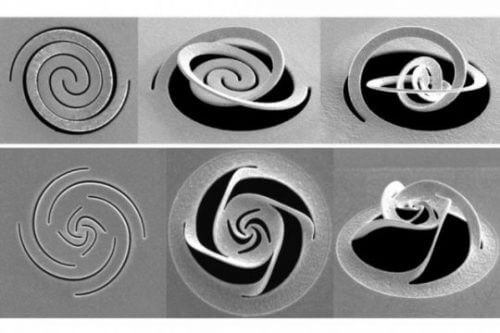In recent years the ancient Japanese art of folding and cutting paper has entered the world of science at the nanometer scale. By folding (origami) and cutting (kirigami) surfaces researchers from MIT were able to create miniature structures that polarize light that could be used in the future by the computer and medical device industry

Credit: Courtesy of the researchers
Researchers from MIT and China have shown for the first time how folding and cutting nanometer surfaces can affect the polarization of light - this method may in the future open up additional areas of research and ultimately create innovative optical means for communication and computing. The findings were published about a week ago (6.7.18) in the journal SCIENCE ADVANCE and were published by Prof. Nicholas X Fang from MIT in collaboration with five other researchers.
Using a well-known chip fabrication method, Fang and his team focused a beam of charged particles on a metal surface to create the precise nanoscale patterns. The method caused the surface to deform and rotate itself in such a way that it would be able to polarize light circularly.
Polarization is a property of light that arises due to its wave properties. The direction of the light's oscillation characterizes its polarization. For example, to create a wave on a rope, you have to swing it at one of its ends - if you shake your hand horizontally, the polarization of the wave created on the rope will be called "horizontal polarization", if you shake the rope vertically, its polarization will be accordingly. It is also possible to create circular waves - if we turn the rope clockwise, a right-polarized wave will be created and the opposite will be left-polarized (counter-clockwise). In fact it is possible to show mathematically that such polarization is a combination of horizontal and vertical polarization.
The nanokirigami that the researchers created was able to polarize the light, that is, selectively transmit circularly polarized light - right or left. To create the nanometer polarizer, Fang's team created blade wheel shapes from scratch that allow choosing the desired polarization that will pass through the surface.
"We cut the surface using ions (charged particles) instead of scissors. With a beam focused on the surface, we create the desired pattern, in the end we get a metallic film that folds and protrudes," said Fang. He added that "this is a wonderful connection between mechanics and optics". Until now, researchers have guessed what is the desired folding that will give the desired polarization, but now thanks to the efficiency of this method, the team has been able to create patterns adapted to the desired polarization without guessing nanometric folding.
There are many uses for nanokirigami - using such nanometer polarizers, for example, you can measure the glucose level. Because the glucose molecule has a defined right or left orientation, it interacts differently with light. If we shine a solution with glucose through the polarizers we can visually see only the right or left glucose molecules. Nanometer polarizers can examine each molecule individually, what is its degree of chirality.
Fang adds that circular polarizers allow light rays to cross each other in optical fibers without disrupting the signal in the fiber. "People are looking for such optical means to transmit laser signals for communication purposes. Now we have shown that it is also possible to create such fibers on the nanometer scale."
For an article published in Science Advance
to the notice of the researchers
More of the topic in Hayadan:

One response
Well done !!